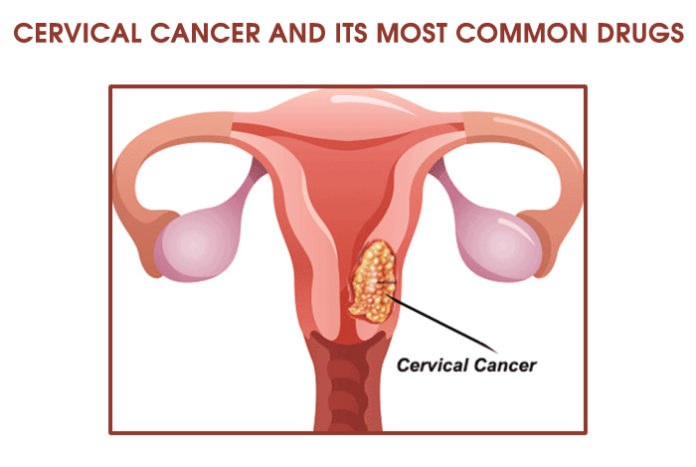
Introduction
Cervix is the lower part of the uterus, which is a major secondary sex organ of females. It is usually 2-3 cm long and connects the uterine cavity with the vagina. When the cells in the cervix become cancerous, it gives rise to a condition known as cervical cancer. These cancerous cells have the ability to invade other tissues and organs of the body as well in the later stages of the disease.
Cervical cancer develops extremely slowly but it is possible to diagnose it in the early stages due to the easy availability of pap smear test in the modern times. Early in the disease, no symptoms are observed. Later on, a number of symptoms like pelvic pain, pain during sexual intercourse and vaginal bleeding can be observed.
The exact cause of cervical cancer has not been identified. However, it has been observed that women with a human papilloma virus (HPV) infection are more likely to develop cervical cancer. But, most of the women who have the infection do not develop cancer. Some of the other risk factors include weak immune system, long term use of contraceptive pills, smoking, becoming sexually active at a younger age and having a number of sexual partners.
Cervical cancer takes 10-20 years to develop from the precancerous stage to a full-blown cancer. There are two types of cervical cancer, adenocarcinoma and squamous cell carcinoma.
Women generally get diagnosed with cervical cancer when they are in the age group of 20- 40 years. Full blown cervical cancer is observed in the women who are in the age group of 50 years. This fact proves that it is possible to stop the disease from becoming a major cancer if it is diagnosed early. [1]
Symptoms
When the cancer is in its early stages, there are no symptoms at all. Therefore, it is important for women in the age group of 20-40 years to get regular pap tests. These tests are extremely useful in not only detecting cancerous cells, but also in detecting any abnormal changes happening in the cervical cells that can lead to cancer in the later years. Early detection of abnormal cells can save the woman from developing this deadly disease.
Some of the most commonly observed symptoms of cervical cancer include:
- Bleeding in between periods
- Bleeding after sexual intercourse
- Bleeding in post-menopausal women
- Discomfort during sexual intercourse
- Abnormal vaginal discharge
- Vaginal discharge mixed with blood
- Pelvic pain
There are different stages of cervical cancer, namely:
- Stage 0, when precancerous cells are present
- Stage 1, in which cancer cells have invaded deeper tissues of cervix and possibly to the uterus and lymph nodes
- Stage 2, when the cancer cells are present beyond the cervix and uterus but not far away from the walls of pelvis or lower part of vagina. It might or might not affect the lymph nodes.
- Stage 3, where cancer cells are found in the lower part of vagina or walls of pelvis. It might start to block the uterus and urinary tubes. It might or might not affect the nearby lymph nodes.
- Stage 4, in which the cancer has spread to the bladder, rectum and is spreading out of the pelvis to other organs of the body like lungs, bones, liver and lymph node.
Treatment
The treatment of cervical cancer depends on the stage of the disease. When the cancer is in the early invasive stage, surgery is the best choice for managing the disease. In more advanced stages, chemotherapy along with radiation is selected for treating the cancer. It requires a multi-disciplinary approach for treating this disease. A whole team of specialists is involved in treating the disease.
The treatment of cervical cancer depends on a number of factors like the type and stage of disease, side effects, women’s preference and the overall health of the patient. Women who undergo treatment for cervical cancer are often concerned with their sexual function and fertility. If a pregnant woman develops cervical cancer, she should discuss it with her doctor as to how the treatment will affect her child.
There are a number of methods available for treating cervical cancer. Surgery, radiation and chemotherapy are the different ways which are used for managing cervical cancer.
Surgery
During surgery, the tumor as well as the healthy tissue surrounding the tumor are removed through different procedures. Some of the surgical procedures that are used for managing cervical cancer include:
- Conization
- LEEP
- Hysterectomy
- Bilateral Sal pingo -Oophorectomy
- Radical Trachelectomy
Radiation Therapy
Radiation therapy utilizes high energy X rays for killing cancer cells. Radiation therapy can be given as a part of the main treatment or along with surgery. For later stages, radiation is given along with chemotherapy for managing the disease. It is also used for treating cancer that returns after a successful treatment of cervical; cancer. There are 2 types of radiation therapies:
- External beam radiation
- Brachytherapy
Chemotherapy
Chemotherapy is given along with radiation therapy for better results to women who are in the stage IB to IV A of cancer. It can also be the main course of treatment for cervical cancer as the disease has a slow rate of progression. Chemotherapy either involves using a single drug or a combination of drugs for the treatment. These medicines are given intravenously and the patient can go home after receiving their dose of medicines.
However, these drugs can damage the healthy tissue as well and have a lot of side effects.
After the treatment, when the cancer has been totally removed from the body, it is necessary to go for regular health checkups, during which the doctor will examine your vagina and cervix, if it has not been removed. Since cervical cancer is known to return, therefore, it is extremely necessary to go for regular checkups.
Some of the drugs that are used for treating the disease are given below:
1. Alkylating Agents
The drugs belonging to this class inhibit the synthesis of DNA cross links which prevents the cell from growing and multiplying.
- Generic Name: cisplatin
Brand Name: Cisplatin
U.S. FDA Status: Approved
Availability: Prescription
Dosage Form: Injection
Indicated in Pregnancy: No
Alcohol Content: Absent
Side Effects: Kidney toxicity, bone marrow depression, ototoxicity, black stools, dizziness, fever, swelling in face and wheezing - Generic Name: ifosfamide
Brand Name: Ifosfamide
U.S. FDA Status: Approved
Availability: Prescription
Dosage Form: Injection
Indicated in Pregnancy: No
Alcohol Content: Absent
Side Effects: Agitation, confusion, fever, hallucinations, sore throat, swollen glands, pale skin and difficult urination
2. Antimetabolites
Antimetabolites are the dugs that interfere with the synthesis of DNA by blocking methylation of nucleotides (deoxy uridylic acid). This prevents the cancer cells from multiplying.
- Generic Name: fluorouracil
Brand Name: Adrucil
U.S. FDA Status: Approved
Availability: Prescription
Dosage Form: Injection
Indicated in Pregnancy: No
Alcohol Content: Absent
Side Effects: Diarrhea, heartburn, black stools, nausea, stomach cramps and fever
3. Antimicrotubular
These agents work by promoting the formation of tubulin dimers which stabilizes the existing microtubules and prevents them from getting disassembled. Microtubules are involved in cell multiplication and by inhibiting it, cancer growth is prevented.
- Generic Name: paclitaxel
Brand Name: Taxol
U.S. FDA Status: Approved
Availability: Prescription
Dosage Form: Injection
Indicated in Pregnancy: No
Alcohol Content: Absent
Side Effects: Black stools, blurred vision, confusion, fever, pale skin and shortness of breath
4. Topoisomerase Inhibitors
Topoisomerase enzyme is involved in catalyzing the breaking and joining of phosphodiester bonds of the DNA during a normal cell cycle. Therefore, rugs that block the action of topoisomerase enzyme disrupt the normal cell cycle, generate single and double stranded DNA that disrupts the integrity of the cell. These breaks ultimately lead to cell death.
- Generic Name: topotecan hydrochloride
Brand Name: Hycamtin
U.S. FDA Status: Approved
Availability: Prescription
Dosage Form: Injection
Indicated in Pregnancy: No
Alcohol Content: Absent
Side Effects: Abdominal pain, pain, black stools, chills, fever, cough, pale skin and chest pain
5. Vascular Endothelial Growth Factor (VEGF) Inhibitor
Vascular endothelial growth factors (VEGF) are involved with promoting the synthesis of new blood vessels. Drugs that block the action of VEGF do not allow new blood vessels to be formed, which inhibits the growth of cancer cell.
- Generic Name: bevacizumab
Brand Name: Avastin
U.S. FDA Status: Approved
Availability: Prescription
Dosage Form: Injection
Indicated in Pregnancy: No
Alcohol Content: Absent
Side Effects: Abdominal pain, pain, black stools, chills, fever, cough, pale skin and chest pain
6. Cytotoxic Antibiotics
These are antibiotics that have the property of killing the cells or inhibit cell growth by preventing DNA synthesis, microtubule and protein function. They get attached between the building blocks of DNA and disrupt the synthesis and function of DNA and RNA.
- Generic Name: bleomycin sulfate
Brand Name: Blenoxane
U.S. FDA Status: Approved
Availability: Prescription
Dosage Form: Injection
Indicated in Pregnancy: No
Alcohol Content: Absent
Side Effects: Abdominal pain, pain, black stools, chills, fever, cough, pale skin and chest pain
Prevention of Cervical Cancer
Although there is no single way to prevent cervical cancer, there are a few things that can be done to decrease the risk of developing cervical cancer. These include cervical screening, avoiding smoking, safe sex practices and cervical cancer vaccination.
HPV vaccines are designed for protecting against cervical cancer. The vaccine is known to provide protection against either 2, 4 or 9 types of HPV. All the vaccines definitely provide protection against HPV type 16 and 18, as they are known to pose maximum risk for cervical cancer. WHO recommends that HPV vaccine should be made a part of the routine vaccination program throughout the world. Following are the different vaccines available for providing protection against the cancer:
- Recombinant HPV bivalent vaccine
- Recombinant HPV quadrivalent vaccine
- Recombinant HPV nonavalent vaccine
OTC Drugs Available
There are no over the counter medicines available for treating cervical cancer. The patients should also try not to self-medicate and take any medicine only after consulting a doctor.





